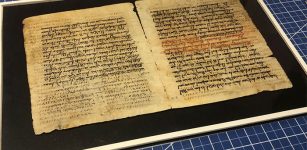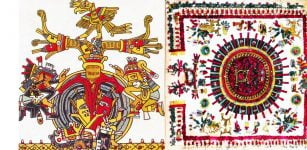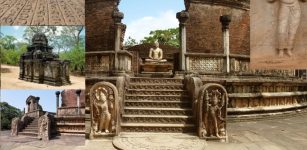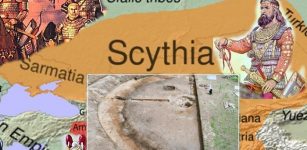Hidden History Of Skull And Crossbones: The Untold Story Of The Templar And Their Connection To The Shining Ones
By: Philip Gardiner – MessageToEagle.com – The enigmatic image of the skull and crossbones is deeply entrenched in the minds of millions around the world as the symbol of piracy, death and even poison.
It was an image that has kept cropping up in my researches, whether Masonic or Templar or even as the symbol that the Christian Jesuits found themselves being inaugurated on, and so I decided that I needed to look deeper into the mysterious rise of this peculiar image.
Whenever we see a pirate ship on television, cinema or in comic books we also see an extremely ancient symbol – the skull and crossbones.
This however, was not a symbol of death or indeed poison but instead it profoundly symbolized life in so many aspects.

Many researchers of Templar and Masonic history have pointed out the links between this symbol and the one used by the Knights Templar on their ships.
If we take into account the fact that the Templars had the world’s biggest fleet in the 13th century, and that they were well known for acts that we would call today ‘piracy’ then there is no wonder.
Many researchers of Templar and Masonic history have pointed out the links between this symbol and the one used by the Knights Templar on their ships.
If we take into account the fact that the Templars had the world’s biggest fleet in the 13th century, and that they were well known for acts that we would call today ‘piracy’ then there is no wonder.
The latter Knights of Malta were also well known for piracy and we find that these Maltese Knights were in fact the very same as the Templars – having been formed or joined by the remnant of the dissolved Templars
These new Templars or Knights of Malta were accused on several occasions of piracy and henceforth we have tales of piracy on the high seas.
There is a direct link therefore between the creation or use of the skull and crossbones by the Knights Templar and our modern day idea of it being a symbol of piracy.
But, I wondered, what explanation did the Knights Templar give for using the symbol? Where did they get it from?
I found a strange tale that is told by most Templar researchers to link the symbol to them and this tale surprisingly involves the number 9, a mother earth image and a skull.
In The Holy Blood and The Holy Grail, Baigent, Leigh and Lincoln tell the tale:
A great lady of Maraclea was loved by a Templar, A Lord of Sidon; but she died in her youth, and on the night of her burial, this wicked lover crept to the grave, dug up her body and violated it.
Then a voice from the void bade him return in nine months time for he would find a son. He obeyed the injunction and at the appointed time he opened the grave again and found a head on the leg bones of the skeleton (skull and crossbones).
The same voice bade him ‘guard it Well, for it would be the giver of all good things’, and so he carried it away with him. It became his protecting genius, and he was able to defeat his enemies by merely showing them the magic head. In due course, it passed to the possession of the order.
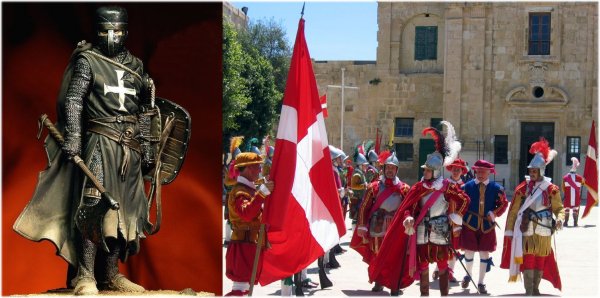
In another version this Lord of Sidon actually ritualistically marries the corpse.
I told this tale to several colleagues in-order to judge the response and in each case the response began with horror and disgust and ended with a lot of head scratching and bewilderment – the reaction that the story in fact was intended to provoke.
Now such stories are naturally seen as macabre and the ‘hidden message’ therefore still evades us – which is the idea. But as I was to discover, what is really being conveyed in these stories, is the importance of the union or balance, which creates a state of enlightenment akin to that spoken of by the Gnostics, alchemists and mystics.
But before I decided this to be the case I wanted to delve deeper and found myself in an ancient world of symbolism and secrecy. There were more nuggets of information in this text, which needed investigation and I decided that it was about time the code was broken. I turned firstly to the main character in the tale, the infamous Lord of Sidon.
As a Titular metropolis of Pamphylia Prima, Sidon, dates as far back as Neolithic times. In the tenth century B.C. Sidon had its own coinage that bore the head of Athena (also Minerva a serpentine, feminine deity linked with healing.) I found that Athena was indeed the patroness of the city even though its people were sometimes termed ‘a piratical horde’ and Constantine Porphyrogenitus called Sidon a ‘nest of pirates.’
However the place did go on to play host to one of Alexander the Great’s garrisons for a while, which was used to subdue this piratical element for Alexander’s own purposes. Under his successors Sidon became known as the ‘holy city of Phoenicia’ and enjoyed relative freedom, with games and competitions attracting people from far and wide.
In 1111 AD the crusader Baldwin, who was later to become King Baldwin of Jerusalem, besieged the city and it was later to become one of the four baronies of the Kingdom of Jerusalem.
It was a very commercial, and in fact, warlike city, with a powerful navy – something the Templars looked up to and emulated.
From early on, Sidon was a rendezvous for pirates, and even the slave trade continued after the fall of slavery elsewhere.
However, by the 14th century, and following the downfall of the Templars, Sidon was on the ‘way out’ as a player on the world market. The lack of water and resources – added to Turkish invasions – led to lack of interest. Sidon was not yet dead in the water though and flourished again briefly in the 17th century when it was rebuilt by Fakhreddine II – the then ruler of Lebanon.
Under Fakhreddine’s guidance it became a base for French merchants who used it as a staging post to further their commercial conquests. Slowly however Sidon again declined until the late 20th century when again it has risen from the ashes to become an important commercial and agricultural centre.
So this was a brief but relevant history of Sidon and its relationship to my story was remarkable. The fact that it was well known as a ‘nest of pirates’ was startling.
I considered also the link of the skull and crossbones to piracy, especially as it was linked to the Templars, and the fact that the Lord from the skull and crossbones story was Lord of Sidon.
So was this Lord of Sidon mentioned in the Templar story really a pirate?
The links between Sidon are strong: Templars were highly commercial and indeed linked to slavery, so was Sidon.
It collapsed in the 14th century, and so did the Templars. It had a huge fleet, and so did the Templars. In fact they were one and the same in many respects – both feeding from one another. The leaders of Sidon were linked with the Templars and would have seen the Templar’s banking system as highly important.
As the Holy Land finally fell to the Muslims in 1291 I found mention of a Templar knight by the name of Tibald Gaudin who is thought to have carried off the famous Templar treasure. When Gaudin finally arrived at the Templar port of Sidon he was elected the next Grand Master – or Lord.
It seems that there were ample financial reserves held at the Sidon Preceptory and so the treasure of the Templars cannot have been gold or otherwise it would not have been mentioned. I am of the opinion that the treasure was the secret of the Holy Grail.
If Sidon had a hidden message in the text then it was simply that the Lord of Sidon was to get the Grail from the Lady of Maraclea – as intimated in the story quoted above – which reveals, and rather symbolically, the means through which he could claim it.
Having now established a link between Sidon and the Templars story I wanted to move on to the other name given that caught my eye – Maraclea.
This peculiar name I found was taken from a site that the Templars had previously held in the 13th century. I wondered whether the name had a symbolic meaning – a name with a hidden message in the language – why else would she be from Maraclea and not Antioch or Acre?
Initially I found the site was called Maraclea because it simply means ‘Clear Waters’ or ‘Sea.’ But I wanted to know why the Templars had used the term and began with the standard etymological practice of breaking the word up into two parts – Mara and Clea. Taking the first part I delved into the world of etymology once more and found some remarkable ‘coincidences.’
Mara in Hebrew means, ‘bitter’ and was a common alternative for Mary – whether the Mother of Jesus or the Magdalene. In Latin it equates to mare, which is ‘water,’ ‘lake,’ ‘sea’ and indeed linked to ‘horse’ (female horse.) In Anglo Saxon I found that the term mara meant ‘greater’ or ‘more.’ In Buddhism Mara is ‘death’ or ‘evil one.’
Mara is said to tempt us like Eve and indeed it was Mara who tempted Buddha on the night before his enlightenment experience. I found this rather intriguing as in the Garden of Eden it was the serpent who supplied the fruit of the tree of knowledge to Eve and therefore he was supplying enlightenment just like Buddha (and Eve as Havveh is equated with female serpent.)
This Mara of the Buddhists I discovered was also closely related to Rama, where ma equates to black or dark, a term associated with beauty and a term also meaning ‘Great Mother.’
Baffled, but also excited by these etymological results and their relationship to the story of the enlightenment or ‘shining’ I quickly moved on to the second part of the word – clea.
When I did look at this word I felt rather stupid as it was perfectly ‘clear’ what it meant. Clea means simply ‘to clean,’ ‘to clear,’ ‘to be clear,’ ‘to be pure,’ ‘to be bright’ or ‘to shine!’
I also noted that this lady of Maraclea, according to theologians and scholars was thought to have come from Armenia. Rife in Armenia at the time was what is known as Paulician Christianity – a Christianity that would not be recognized by most today.
I decided not to delve too deeply into this theology, but did find that this spawned the Bogomils who have been linked to, and were even called the same as the infamous Cathars or ‘Perfect Ones’ – i.e., ‘Illumined/Shining Ones’ or ‘Pure Ones.’
I ran through the variants that were now possible:
- Mary Pure – well no, that didn’t work.
- Water Bright – this didn’t really relate.
In fact there were numerous configurations that I could have made.
In the end I landed on two that just seemed to make perfect sense and related etymologically in the Anglo Saxon for both words – without mixing up the languages. The result sent a shiver up my spine as I realized the two meanings of Maraclea.
The first one was,
- Black-Clear or Dark-Clear.
Well this was significant in the Gnostic sense, as the contradictory nature of the words revealed the duality spoken of by the Gnostics and Manicheans – light and dark, male and female.
These were the two sides of our minds – a revelation of our own divided consciousness. It was in fact the very same element spoken of throughout time as the generative source of all religions – for by overcoming this duality and finding balance and union, or a neutral state, we become enlightened to our own true self and often enter a spiritual state of illumination or ‘shining’.

The other meaning of the name Maraclea was equally astounding and related even more to the concept of illumination. It was ‘Greater Shining’.
However, there was even more meaning in this interpretation. Standing back for a moment I wondered about the whole thing. Here I have a Lord of Sidon, possibly a Templar knight, if indeed not a Grand Master, coming into union with the ‘Greater Shining.’
What could it possibly mean other than this Templar was a ‘Shining One’ and therefore experienced the Holy Grail of enlightenment for himself?
The result of his union would be the head or skull 9 months later (although another version says 9 years,) and as I was to discover in my researches into the Temple of Jerusalem, the number 9 was of paramount importance to the Templars.
The head was also definitely being used as a metaphor for this internal process, which actually involved the head or something within it. This in itself gives us a greater insight to the argued over Baphomet head that the Templars were said to have worshipped.
Strange also then that 9 Knights set up the Templars and 9 years later return to Rosslyn Chapel with supposedly the Holy Grail tucked away in a bag. But, I decided maybe I should take another look at the number 9, which is a reversed P – something, which would soon become strangely more relevant.
I decided in this instance to just take a look at language rather than numbers and so consulted the Encyclopedia of Word and Phrase Origins by Robert Hendrickson.
Nine days’ Wonder – Minor marvels, things that cause great sensations for a short time and then pass into limbo… Kittens, puppies, and other young animals have their eyes closed for a number of days [9] and then open them and see the light….
Amazingly this is mirrored in folktales, myth and legend and therefore in the significance of the number we have here a period of 9 months where the female is pregnant (and thus rebirth); 9 months or years for the Lord of Sidon to receive his prize; and 9 days before the new born animals see the light – it all made complete sense.
So, the skull and crossbones is linked to the number 9 and again, enlightenment and the Holy Grail – which are both seen as good, pure and holy. Indeed, was not the Holy Grail said to be the giver of all good things, just like the head in the Templar tale, ‘guard it Well, for it would be the giver of all good things.’ If this Greater Shining were truly the Holy Grail then it would bring him good things for sure.

It became his protecting genius.
Others have found this part of the text very strange, however I understood what it meant immediately, and for confirmation I looked up the meaning in a standard dictionary and found perfect corresponding evidence for the Greater Shining.
Genius, inborn faculty. (L.) – L. genius, the tutelary spirit of any one; also wit, lit. ‘inborn nature.’ Allied to genus.
So, this ‘Greater Shining,’ this ‘head,’ became his inborn faculty or inborn nature. The two were the same.
There is a subtle underground symbolism going on here. The Lord of Sidon (a Templar) mates with the Lady of Maraclea (a Cathar) and we have an inborn nature called genius. Suddenly the Skull and Crossbones symbol, as explained in the Templar text is revealed before our eyes.
At this point it crossed my mind that I had only gone back to the Templars. I wondered just how far back in time I could possibly go with this skull and crossbones image?
The earliest reference to the actual skull and crossbones I could discover was the Templar reference. However, taking the image as symbolic, which is what it indeed was, then we are looking for the shape – a skull or head with a diagonal cross or saltaire below.
Amazingly, I found this in Ancient Egypt and on the tomb of Tutankhamen.
Carrying a staff or sceptre was, in ancient Egypt, a symbol of universal power. The Flail was used to beat animals (or indeed people) into submission and shows authority like the sceptre – hence their interchangeable nature.
The crook was a shepherd’s tool, used to pull stray animals by the neck without hurting them. Here we have an image of push and pull. This shepherd aspect of the king is as old as Mesopotamia and possibly beyond.
These two symbols reveal the two opposites of the duality spoken of by the Gnostics, the push (positive/male) and pull (negative/feminine). Anyone therefore that mastered these symbols had mastery over the self and the enlightened connection or ‘shining’.
Tutankhamen was seen with these devices held upon the chest in the diagonal cross form, making a replica of the skull and crossbones in form, whereas many other Pharaohs held them outwardly away from each other.
When dead, the king becomes Osiris, and I find that this same image is seen upon Osiris and is therefore his symbol – a symbol of the ultimate universal power and borrowed by his earthly representative the Pharaoh.
The symbolism now becomes open to see
Osiris is the archetypal resurrecting god – a symbol of regeneration, akin to the power of the Templar in the text.
So the Templar is symbolically the same as Osiris on Earth. No wonder that Christ is called the ‘good shepherd’ – as was Osiris who was called the ‘good god.’
So here I was tracing back the image of the skull and crossbones back into ancient Egypt and even Mesopotamia. It should have been no surprise, as this is the home of the ancient and original Shining Ones. And yet, amazingly there was more to come. I turned my gaze even more laterally and found another symbol related entirely to both the skull and crossbones and the Egyptian influence.
This separate and more obscure image also closely resembled the skull and crossbones and over it a ‘holy war’ has raged for decades.

The symbol is now commonly known as the Chi-Rho – so-called because it is composed of the Greek letters chi (X) and rho (P).
The war over these two letters is fought between Christians and historians; between fundamentalists on both sides and yet both sides are missing the point.
The Christians claim that the Chi-Rho form the first two letters of Christ (Cristos) and the historians claim that the symbol can be found hundreds if not thousands of years before Christianity and was therefore usurped by them. I needed to look into this to discover the origins, meaning and why it so resembled the style of the skull and crossbones.
An identical symbol to the Chi-Rho has been found inscribed on rocks dating from 2,500 BC Sumeria, and was interpreted as ‘a combination of the two Sun-symbols’ – symbols of the ancient shining ones.
It was also used on the coins of Ptolemeus III from 247-222 BC, as well as being an emblem of the Chaldean sky/sun god and has the definition ‘Everlasting Father Sun’ (From An Illustrated Encyclopedia of Traditional Symbols)
I then noted that other meaning for clea, – which was ‘pure.’ Could it be that this link was even well known in Templar times?


The feeling of stupidity quickly drained away as I suddenly realized what the term Maraclea meant – a word that has been missed by thousands of Templar historians the world over and yet is a key to unlocking the secret of this peculiar text.
According to Sir Flinders Petrie – the Egyptologist – the monogram Chi-Rho was the emblem of the Egyptian god, Horus, thousands of years before Christ and is therefore a link between Horus the savior, and Christ the savior.
I had already noted on several occasions the links between these ancient characters and so this was highly believable and conclusive.
To others it is in this second century B.C. where the secret of the monogram lies with the Greek Ptolemy’s who are said to have ‘borrowed’ it from the Africans. In this scenario the Greeks called their version of Horus, Herecles or Hercules and applying the Greek Xpnc (Chres) to him. This suddenly gave the ancient Horus the title of Lord, Chrestos, and inevitably ‘Christ.’
This, if true, shows again the direct link between Horus, the Chi-Rho monogram and Christ.
Indeed many European scholars have actually identified Heracles or Hercules as none other than an emblem of Jesus Christ. I had to bear in mind that the name Heracles, is related to Hero and Hu, which means, ‘shining,’ but are also related etymologically to Christ, showing that these titles of the Messiah are directly derived from the word Heru which is of African origin and can be found the world over as a word for the sun.

But there were even more links, as I discovered. The Greek title Christ is, like Heru, also derived from an Egypto-African word Karast, and Kristos or Christos is the KRST (Karast).
Karast is a person who is anointed (enlightened or shining) as a Heru (Hero) during his or her own lifetime. It is only when deceased that one receives the great term ‘a KRST’ or Ausur. This Ausur is none other than Osiris, the same Egyptian god I found with the skull and crossbones symbol with the flail and sceptre.
The anointing, in the physical sense, (as the anointing also applies in the spiritual sense,) derived from the body or cadaver being anointed with spices, oils, and resins to preserve it. The body is then wrapped in bandages, placed in a coffer, which is then placed upright to symbolize resurrection.
It was believed that in the plural, the Herus (Heroes) or Krst’s (Christs) would rise again to save the world as fully divine beings and thus become the ‘once and future king.’ It seems then that this tradition came out of Africa, through Egypt and into Greek and Christian legend and brought with it the original symbols of Osiris.
So, amazingly we have a link between the Chi-Rho and the symbol of Osiris – god the father of Horus or Christ. No wonder that a philological and historical war rages and that Christianity refuses to accept this remarkable link.
So, I wondered, what do the Christians believe this Chi-Rho to derive from? Well, I found that it goes back to Constantine and was an amazing propaganda device to establish the new Roman, and therefore to become, Catholic Empire.
The story goes that Constantine had a vision before a great battle and was told that with the symbol of the Chi-Rho, which they called the Labarum, he would gain victory – ‘By this sign, you will conquer.’
Using the new Labarum as his battle standard, which would relate to everybody, Constantine took the field and the Empire was ‘born again.’
In fact, the Christians had been using this symbol secretly as a sign of their faith and Constantine (or somebody who advised him) simply picked up on the fact that this symbol and the whole savior process was as ancient and widespread as I am outlining here – and according to some – it was used to plunder the treasuries of the pagan temples.
Amazingly, on the coinage during and after Constantine’s death, we see the Laburnum or Chi-Rho (image right), underlined with the serpent – a symbol used throughout time and especially by the Gnostics for wisdom and the enlightenment process.
Strangely, just as the biblical term, Elohim, is a plural word used for God (EL), and in reality means the ‘Shining Ones,’ the X part of the monogram is also plural (X=10) and is the number of Yahweh.
Chi also has another meaning – ‘Great Fire’ or ‘Light’ or even ‘Shining.’
The P (Rho) part is more difficult but has been related to ‘Pen’ (pen means, ‘head’) in etymology thus implying that the loop on the top of the P is a head, in the very place that a skull would be on the skull and crossbones.[3] [One thing is sure, Rho stood for ‘Pater’ or ‘Patah’ (the Egyptian god Ptah), which is ‘Father.’ Together they therefore make ‘Shining Father’ (Dyaus Pitar) – which later became the Roman ‘Jupiter’ (Hu Ptah=father sun) – the Roman version of the Greek father-god Zeus.]
I found that the symbol of the skull and crossbones then, stretches back over thousands of years and relates entirely to the ancient ‘Shining Ones’ – and directly to Osiris, the Egyptian version of the original ‘Shining Father’ incarnated on earth.
Not only that, but geographically it goes right into the heart of original Shining territory.
But, I again had questions: Why the X?
I believe that the X marks the spot in more ways than can be imagined. It is the crossing point of the two dual energies and it is the centre where the true enlightenment is engaged – where the two opposites meet. With the upright world axis running through the X we also have a dividing line, but it is also a six-pointed symbol and is akin to the Star of David or Seal of Solomon, which is also an ancient symbol with much the same meaning.
The six points are important, as they reveal the seventh point and most holy – the centre of the X.
See also:
- Secrets Of The Stars: Tracing The Origins Of Ancient Cults And Cabals
- Chartres – Symbol Of Power And Secret Ancient Knowledge
- Identity Of The Shining Ones Revealed – One Of The Greatest Secrets Ever Kept From Mankind
I was tempted to look into the infamous Skull and Bones secret society of Yale University so famously joined by Bush Senior and Junior, as well as many other extremely powerful individuals, but decided I was straying too far into the world of conspiracy theories that had little or no substance and so I left well alone.
However, as I was to discover with the Jesuits, who swear an oath upon the symbol of the skull and crossbones, I found that the Freemasons also have this symbol and utilize it without too much knowledge of its origin – or so we are led to believe.
However, what was intriguing was the ‘degree’ that utilized the symbol – the Knights Templar.
In the George Washington Masonic Memorial in Virginia, USA, there is an anteroom with a large portrait of the Colonial period Grand Master Lafayette wearing the Templar Apron bearing the ‘skull and crossbones.’
The same apron images have also been found elsewhere, such as Michigan, Detroit and Jackson and I am sure that these are not the only ones, as several members have also pointed out to me that they too have seen the aprons.
According to Masonic history the apron can only be dated back to the late 18th century and to the revisions carried out by Thomas Smith Webb where he pointed out that,
‘The flap black, and a skull and cross bones embroidered in silver thereon.’
On another apron is described by Cornelius Moore in 1859:
An Apron of black velvet of a triangular form, trimmed in silver lace.
On the top or flap is a triangle, with twelve holes perforated through it; in the centre of the triangle is a cross and serpent; on the centre of the apron is a scull and cross bones, and at equal distance from them, in a triangular form, a star with seven points; in the centre of each star a red cross.
~From The Craftsman and Freemasons Guide, 1859
The reasoning behind having this skull and crossbones on the Masonic apron, is revealed in a story with which I began – the story about a Lord of Sidon…
Copyright © Philip Gardiner – MessageToEagle.com Contributor
About the author:
Philip Gardiner – is the international best selling author of “The Shining Ones, Secrets of the Serpent and the critically acclaimed Gnosis, the Secret of Solomon’s Temple Revealed. He has appeared on hundreds of radio and television programs worldwide and is often referred to as the “next Graham Hancock”. He has infiltrated various secret societies and been initiated into Orders many people had thought were long forgotten. Committed to his mission to uncover the real history of mankind and the unraveling of manipulative propaganda, he has come up against many obstacles and yet in his books and DVD’s consistently uncovers vital information and provides insights into the mysteries of the ancients and the nature of reality. He lives in the heart of Robin Hood country in the UK and travels the world on a personal quest to uncover the truth.
Visit his website: Gardiner’s World



